what was the major threat to byzantium in the late 900s?
The Byzantine Empire, often called the Eastern Roman Empire or simply Byzantium, existed from 330 to 1453. With its capital founded at Constantinople past Constantine I (r. 306-337), the Empire varied in size over the centuries, at once or another, possessing territories located in Italy, Greece, the Balkans, Levant, Asia Minor, and North Africa.
Byzantium was a Christian country with Greek as the official linguistic communication, the Byzantines developed their own political systems, religious practices, fine art and architecture, which, although significantly influenced by the Greco-Roman cultural tradition, were distinct and non merely a continuation of ancient Rome. The Byzantine Empire was the longest-lasting medieval ability, and its influence continues today, especially in the religion, art, compages, and law of many Western states, Eastern and Central Europe, and Russian federation.
Names & Dates
The proper name 'Byzantine' was coined past 16th-century historians based on the fact that the uppercase city's first name was Byzantium earlier information technology changed to Constantinople (modern Istanbul). It was and continues to exist a less-than-perfect but convenient characterization which differentiates the Eastern Roman Empire from the Western Roman Empire, peculiarly important after the fall of the latter in the 5th century. Indeed, for this reason, at that place is no universal agreement among historians equally to what period of fourth dimension the term 'Byzantine Empire' actually refers to. Some scholars select 330 and the foundation of Constantinople, others the Fall of the Western Roman Empire in 476, nevertheless others prefer the failure of Justinian I (r. 527-565) to unify the 2 empires in 565, and some fifty-fifty plum for c. 650 and the Arab conquest of Byzantium'southward eastern provinces. Most historians practice agree that the Byzantine Empire terminated on Tuesday 29 May 1453, when the Ottoman Sultan Mehmed 2 (r.1444-6 & 1451-81) conquered Constantinople.
Constantinople became the richest, almost lavish & well-nigh important Christian city in the globe.
The discussion of dates also highlights the differences in the ethnic and cultural mix betwixt the 2 halves of the Roman world and the distinctness of the medieval country from its earlier Roman heritage. The Byzantines called themselves 'Romans', their emperor was basileon ton Rhomaion or 'Emperor of the Romans' and their capital was 'New Rome'. However, the most mutual linguistic communication was Greek, and information technology is fair to say that for the vast majority of its history, the Byzantine Empire was much more than Greek than Roman in cultural terms.
Constantinople
The beginnings of the Byzantine Empire lie in the conclusion of Roman emperor Constantine I to relocate the capital of the Roman Empire from Rome to Byzantium on 11 May 330. The popular name Constantinople or 'City of Constantine' presently replaced the emperor'due south ain official selection of 'New Rome'. The new majuscule had an excellent natural harbour on the Gold Horn inlet and, straddled on the border between Europe and Asia, could control the passage of ships through the Bosphorus from the Aegean to the Black Bounding main, linking lucrative merchandise between west and due east. A groovy chain stretched across the Golden Horn's entrance, and the construction of the massive Theodosian Walls betwixt 410 and 413 meant that the city was able to withstand time and over again concerted attacks from both ocean and state. Over the centuries, as more spectacular buildings were added, the cosmopolitan city became one of the finest of any epoch and certainly the richest, near lavish and most important Christian city in the world.

Map of Byzantine Constantinople
Byzantine Emperors
The Byzantine emperor or basileus (or more rarely basilissa for empress) resided in the magnificent Great Palace of Constantinople and ruled as an absolute monarch over a vast empire. As such, the basileus needed the assist of an skilful government and a widespread and efficient bureaucracy. Although an absolute ruler, an emperor was expected - past his government, people and the Church building - to rule wisely and justly. Fifty-fifty more chiefly, an emperor had to have military success every bit the army remained the near powerful establishment in Byzantium in real terms. The generals in Constantinople and the provinces could - and did - remove an emperor who failed to defend the empire'south borders or who brought economic catastrophe. Nonetheless, in the normal run of events, the emperor was commander-in-primary of the army, head of the Church building and government, he controlled the state finances and appointed or dismissed nobles at will; few rulers before or since take e'er wielded such power.
Through a carefully orchestrated continuity of dynasties, ritual, costume & names, the establishment of the Byzantine Emperor was able to last for 12 centuries.
The emperor's epitome appeared on Byzantine coins, which were too used to show a called successor, often the eldest son, but not always as at that place were no set rules for succession. Emperors were thought to have been called by God to govern, simply a magnificent crown and robes of Tyrian royal helped further bolster the correct to rule. Another marketing strategy was to re-create the reign names of illustrious predecessors, Constantine existence a item favourite. Even usurpers, typically military men of power and success, very ofttimes sought to legitimise their position past marrying a member of their predecessors family. Thus, through a advisedly orchestrated continuity of dynasties, ritual, costume, and names, the establishment of the emperor was able to terminal for 12 centuries.
Byzantine Government
The Byzantine government followed the patterns established in imperial Rome. The emperor was all-powerful but was still expected to consult such important bodies as the Senate. The Senate in Constantinople, unlike in Rome, was composed of men who had risen through the ranks of the military machine service, and so there was no senatorial form equally such. Without elections, Byzantine senators, ministers, and local councillors largely acquired their position through regal patronage or because of their condition as large landowners.

Justinian I
The elite senators made upwards the minor sacrum consistorium which the emperor was, in theory, supposed to consult on matters of land importance. In add-on, the emperor might consult members of his personal entourage at court. Also at courtroom were the eunuch chamberlains (cubicularii) who served the emperor in various personal duties but who could likewise control admission to him. Eunuchs held positions of responsibility themselves, principal amongst these being the holder of the emperor's purse, the sakellarios, whose powers would increase significantly from the 7th century. Other important government officials included the quaestor or principal legal officeholder; the comes sacrarum largitionum who controlled the state mint; the magister officiorum who looked after the general administration of the palace, the ground forces and its supplies, as well every bit foreign affairs; and a team of imperial inspectors who kept an middle on affairs in local councils across the empire.
The superlative official in Byzantium, though, was the Praetorian Prefect of the East to whom all regional governors of the empire were accountable. The regional governors supervised the individual city councils or curae. Local councillors were responsible for all public services and the collection of taxes in their town and its surrounding lands. These councils were organised geographically into 100 or so provinces which were themselves arranged into 12 dioceses, 3 in each of the empire's 4 prefectures. From the 7th century the regional governors of the dioceses, or themes as they became known after a restructuring, in upshot, became provincial military commanders (strategoi) who were directly responsible to the emperor himself, and the Praetorian Prefect was abolished. After the 8th century the administration of the empire, due to the increased military threat from neighbours and internal civil wars, became much more simplified than previously.
Corpus Juris Civilis
Byzantine authorities was greatly assisted by the creation of the Justinian Lawmaking or Corpus Juris Civilis (Corpus of Civil Law) by Justinian I. The corpus, drawn up past a panel of legal experts, collected, edited, and revised the huge trunk of Roman laws which had been accumulated over the centuries - a massive number of majestic edicts, legal opinions, and lists of crimes and punishments. The code, equanimous of over a million words, would concluding for 900 years, brand the laws clearer for all, reduce the number of cases unnecessarily brought before the courts, speed upward the judicial process and influence most legal systems in western democracies thereafter.
Byzantine Society
The Byzantines gave dandy importance to the family name, inherited wealth, and the respectable nativity of an individual. The individuals in the higher levels of society possessed these 3 things. Wealth came from land ownership or the administration of state under an individual ambassador'southward jurisdiction. However, in that location was no aristocracy of blood as such in Byzantine society, and both patronage and education were a means to climb the social ladder. In addition, the dispensing of favours, lands, and titles by emperors, equally well as indiscriminate demotions and the hazards of foreign invasions and wars, all meant that the individual components of the nobility were non static and families rose and cruel over the centuries. Rank was visible to all members of society through the use of titles, seals, insignia, particular clothing, and personal jewellery.
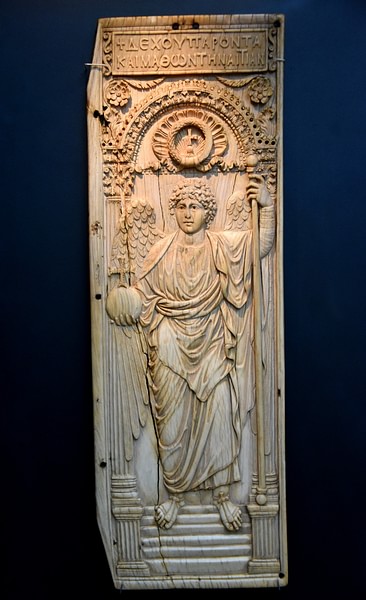
Byzantine Ivory Diptych Console
Most in the lower classes would have followed the profession of their parents, only inheritance, the aggregating of wealth, and a lack of any formal prohibition for 1 grade to motion to another did at to the lowest degree offer a pocket-sized possibility for a person to better their social position. In that location were workers with better jobs such every bit those who worked in legal affairs, administration, and commerce (not a very esteemed way to brand a living for the Byzantines). On the side by side rung downwards were artisans, so farmers who endemic their own pocket-size parcels of land, then the largest group - those who worked the state of others, and finally, slaves who were typically prisoners of war but nowhere near every bit numerous as free labourers.
The office of Byzantine women, as with the men, depended on their social rank. Aristocratic women were expected to manage the abode and intendance for the children. Although able to own property, they could not hold public part and spent their free time weaving, shopping, going to church building or reading (although they had no formal education). Widows became the guardian of their children and could inherit equally with their brothers. Many women worked, as men, in agriculture and diverse manufacturing industries and food services. Women could own their own state and businesses, and some would have improved their social position through marriage. The least respected professions were, as elsewhere, prostitutes and actresses.
Territories of the Byzantine Empire
The geographical extent of the Byzantine Empire inverse over the centuries as the military successes and failures of individual emperors fluctuated. Territories which were held in the earlier part of the empire'southward history included Egypt, Syria, Jordan, Lebanese republic, and Palestine. Greece was less important in practical terms than information technology was as a symbol of the Byzantine'due south view of themselves as the true heirs of the Greco-Roman culture. Italy and Sicily had to exist dedicated, ultimately unsuccessfully, confronting the ambitions of the Popes and the Normans. The Balkans up to the Danube River were important throughout, and Asia Minor upward to the Black Sea coast in the north and Armenia in the east was a major source of wealth, but both these regions would require regular and vigorous defence against diverse perennial enemies.
As the political map was constantly redrawn with the rising and fall of neighbouring empires, notable events included Anastasios I (491-518) successfully defending the empire against both the Persians and Bulgars. Justinian I, aided past his gifted general Belisarius (c. 500-565), won back territories in North Africa, Spain, and Italian republic which had been lost by the western emperors. The Lombards in Italy and the Slavs in the Balkans made inroads into the Empire during the second one-half of the sixth century, a situation eventually reversed by Heraclius (r. 610-641), effectively bringing the Persian Sasanian Empire to an finish with his victory at Nineveh in 627.
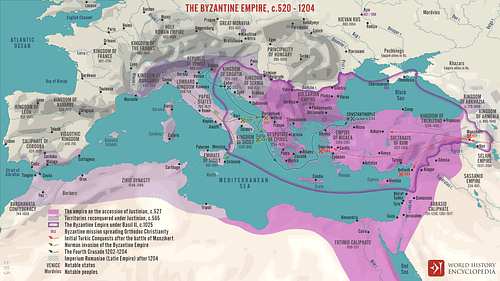
The Byzantine Empire, c.520 - 1204
The Islamic conquests of the 7th and 8th century robbed the Empire of its territories in the Levant (including Jerusalem in 637), Due north Africa and eastern asia Minor. At to the lowest degree, though, the Empire stood house every bit a bulwark confronting the Arab expansion into Europe, with Constantinople twice withstanding determined Arab sieges (674-eight and 717-18). The Byzantine Empire was shaken to its foundations, though. Then in the 9th century, the Bulgars made significant incursions into the northern areas of the Empire. A resurgence in Byzantine fortunes came with the (inappropriately named) Macedonian dynasty (867-1057). The founder of the dynasty, Basil I (r. 867-886), reconquered southern Italy, dealt with the troublesome Cretan pirates, and gained victories against the Arabs on Cyprus, mainland Greece and in Dalmatia. The very side by side emperor, Leo Half-dozen (r. 886-912) lost almost of the gains, simply the mid-tenth century saw victories in Muslim-controlled Mesopotamia.
Basil 2 (r. 976-1025), known as the 'Bulgar-Slayer' for his victories in the Balkans, oversaw another startling upturn in Byzantine fortunes. Basil, helped by an army of fierce warriors of Viking descent from Kiev, as well won victories in Greece, Armenia, Georgia, and Syria, doubling the size of the Empire. It was though, the last great hurrah as a gradual decline set in. After the shocking defeat to the Seljuks at the Battle of Manzikert in Armenia in 1071, a cursory revival occurred nether Alexios I Komnenos (r. 1081-1118) with victories against the Normans in Dalmatia, the Pechenegs in Thrace, and the Seljuks in Palestine and Syrian arab republic (with the help of the Beginning Crusaders), simply there seemed to be too many enemies in as well many regions for the Byzantines to prosper indefinitely.
In the 12th and 13th century the Sultanate of Rum took half of Asia Minor, and so disaster struck when the armies of the Fourth Crusade sacked Constantinople in 1204. Carved up between Venice and its allies, the Empire existed only in exile earlier a restoration in 1261. By the 14th century the Empire consisted of a pocket-size surface area in the tip of southern Hellenic republic and a chunk of territory around the capital. The last blow came, as already mentioned, with the Ottoman sack of Constantinople in 1453.
The Byzantine Church
Paganism continued to be practised for centuries after the foundation of Byzantium, but it was Christianity which became the defining feature of Byzantine civilization, profoundly affecting its politics, foreign relations, and fine art and architecture. The Church was headed by the Patriarch or bishop of Constantinople, who was appointed or removed by the emperor. Local bishops, who presided over larger towns and their surrounding territories and who represented both the church and emperor, had considerable wealth and powers in their local communities. Christianity, then, became an important mutual denominator which helped bind together diverse cultures into a single empire which included Christian Greeks, Armenians, Slavs, Georgians, and many other minorities, and those of other faiths such every bit Jews and Muslims who were permitted to freely practise their religion.
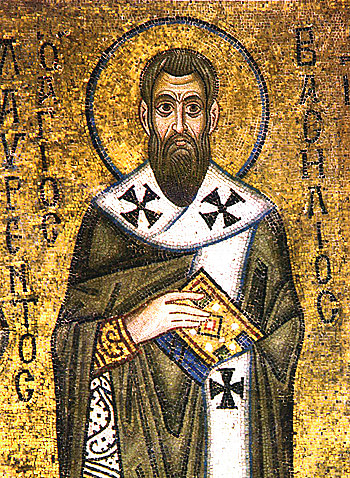
Icon of Saint Basil
The differences in the eastern and western church was 1 of the reasons that the Byzantine Empire received such a poor representation in western medieval histories. Frequently Byzantines were portrayed as corrupt and shifty, their culture brackish, and their religion a unsafe heresy. The churches of the east and due west disagreed on who should have priority, the Pope or the Patriarch of Constantinople. Matters of doctrine were also contested, such as did Jesus Christ have 1 human and one divine nature combined or just a divine nature. Clerical celibacy, the use of leavened or unleavened bread, the linguistic communication of service, and the use of imagery were all points of differences, which, with the fuel of political and territorial ambitions added into the volatile mix of emotions, led to the Church Schism of 1054.
The Byzantine church also had its own internal disputes, well-nigh infamously the iconoclasm or 'destruction of images' of 726-787 and 814-843. The Popes and many Byzantines supported the use of icons - representations of holy figures merely especially Jesus Christ. Those against icons believed they had get idols and information technology was blasphemous to think that God could be represented in art. The issue also reignited the debate over whether Christ had ii natures or one and whether an icon, therefore, merely represented the human. Defenders of icons said that they were merely an artist's impression and helped the illiterate meliorate empathize the divine. During the wave of iconoclasm, many precious artworks were destroyed, specially during the reigns of Leo III (r. 717-741) and his successor Constantine Five (r. 741-775) when even people who venerated icons (iconophiles) were persecuted. The issue was resolved in favour of icons in 843, an event known equally the "Triumph of Orthodoxy".
Monasticism was a particular feature of Byzantine religious life. Men and women retired to monasteries where they devoted their lives to Christ and helping the poor and sick. In that location they lived a simple life according to rules laid out by such important church building figures as Basil the Dandy (c. 330 - c. 379). Many monks were as well scholars, most famously Saint Cyril (d. 867) who invented the Glagolitic alphabet. A notable woman who used her time of retreat well was Anna Komnene (1083-1153), who wrote her Alexiad on the life and reign of her male parent Alexios I Komnenos (r. 1081-1118). Monasteries thus became invaluable repositories of texts and knowledge while their wine-production and icon workshops were greatly appreciated, too. One of the nigh celebrated monastic sites is Mount Athos about Thessalonica, where monks established themselves from the 9th century, eventually building 46 monasteries in that location, many of which survive today.
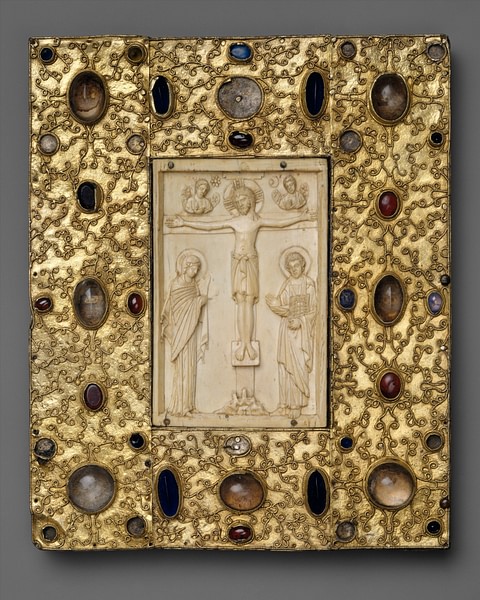
Byzantine Book Cover with Icon
Byzantine Art
Byzantine artists moved away from the naturalism of the Classical tradition towards the more abstract and universal, displaying a definite preference for two-dimensional representations. The rarity of signatures on works of art produced before the 13th century suggests that artists did not relish a high social status. Artworks which promoted a religious bulletin - principally the need for salvation and a reinforcement of religion - were produced in huge numbers and chief amongst these were wall mosaics, wall paintings, and icons. Although icons could take almost any form of material, the near popular were small painted wooden panels. Designed to be carried or hung on walls, they were made using the encaustic technique where coloured pigments were mixed with wax and burned into the wood equally an inlay. With the purpose of facilitating advice between the onlooker and the divine, the unmarried figures are typically full frontal with a nimbus or halo around them to emphasise their holiness.
Byzantine mosaics, best seen today in the Hagia Sophia in Istanbul or the church of San Vitale in Ravenna, represented holy figures, emperors and empresses, church building officials, and scenes of daily life, peculiarly in agriculture. Big-scale sculpture seems to take been less pop than in earlier artifact, just sculpted marble sarcophagi were produced in great numbers. Finally, metalwork, especially incorporating enamel-work and cabochon semi-precious stones, was a Byzantine speciality, and artisans produced many loftier-quality and intricately designed plates, cups, jewellery of all kinds, book covers (specially for Bibles), and reliquaries (boxes for keeping holy relics).
Byzantine Architecture
Byzantine architects continued to apply the Classical orders in their buildings and took ideas from the Near E, amid other places. Designs became more eclectic than in antiquity, especially given the common addiction of reusing the materials from older buildings for new structures. There was, also, a definite emphasis on function over grade and a greater concern with the interiors rather than exteriors of buildings. Continuing to build such quintessentially Roman structures as biconvex aqueducts, amphitheatres, hippodromes, baths and villas, the Byzantines would add to the repertoire with their domed churches, walled monasteries, and more sophisticated fortification walls.
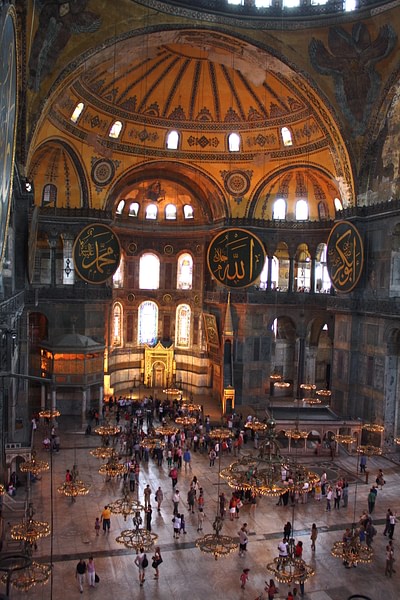
Hagia Sophia Interior
Favoured building materials were large bricks with mortar and concrete for the hidden core of walls. Ashlar stone blocks were used in more than prestigious public buildings while marble, used more sparingly than in before Roman times, was generally reserved for columns, door and window frames, and other decorative elements. Roofs were of timber while interior walls were frequently covered in plaster, stucco, thin marble plaques, paintings, and mosaics.
The largest, most important and still most famous Byzantine building is the Hagia Sophia of Constantinople, defended to the holy wisdom (hagia sophia) of God. Built anew in 532-537, its basic rectangular shape measures 74.6 x 69.7 metres (245 x 229 ft) and its huge domed ceiling is 55 metres in a higher place the floor, spanning 31.8 metres in bore. Resting on four massive arches with four supporting pendentives, the dome was a spectacular architectural achievement for the period. The Hagia Sophia remained the biggest church in the world until the 16th century and was 1 of the most decorated with superb glittering mosaics and wall paintings.
Christian churches, in general, were i of the Byzantine'due south greatest contributions to architecture, especially the use of the dome. The cross-in-square program became the nearly common with the dome built over four supporting arches. The square base of the building so branched into bays which might themselves have a one-half or full dome ceiling. Some other mutual characteristic is a central apse with 2 side-apses at the eastern finish of the church. Over fourth dimension, the key dome was raised ever college on a polygonal drum, which in some churches is so high it has the appearance of a belfry. Many churches, especially basilicas, had aslope them a baptistry (usually octagonal), and sometimes a mausoleum for the founder of the church and their descendants. Such Byzantine design features would go on to influence Orthodox Christian compages and so are still seen today in churches worldwide.
This article has been reviewed for accuracy, reliability and adherence to bookish standards prior to publication.
Source: https://www.worldhistory.org/Byzantine_Empire/
0 Response to "what was the major threat to byzantium in the late 900s?"
Post a Comment